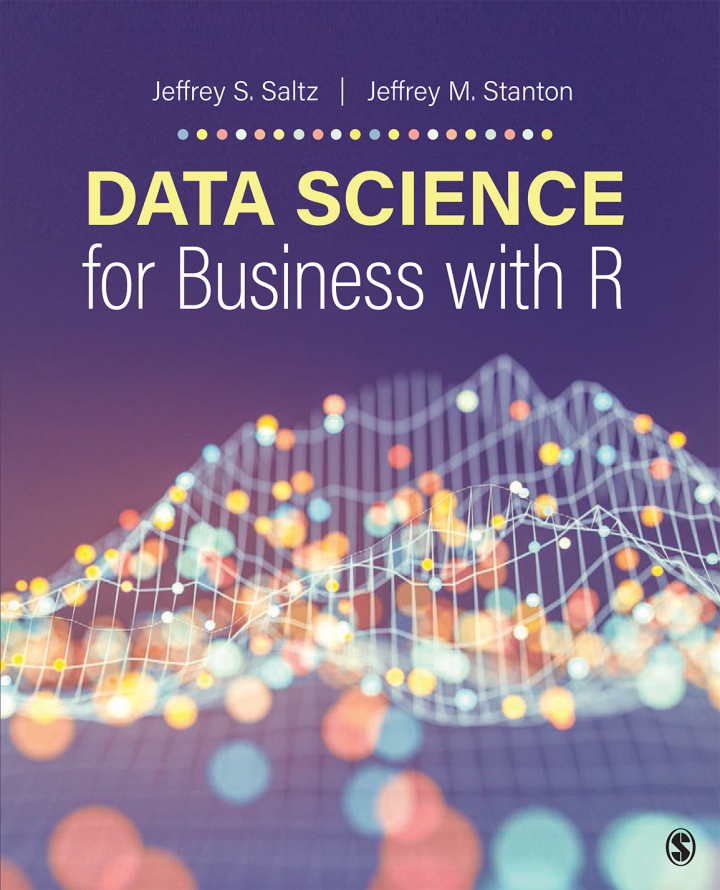
Data Science for Business With R 1st Edition
PUBLISHER: Sage
Trường ĐH, Nhóm, Thư Viện: Gọi 0915920514 để báo giá eBook hosting trên Vital Source hoặc mua Sách In
Khoa học dữ liệu cho doanh nghiệp với RKhoa học dữ liệu cho doanh nghiệp với R, được viết bởi Jeffrey S. Saltz và Jeffrey M. Stanton, tập trung vào các khái niệm nền tảng cho sinh viên bắt đầu chương trình cấp bằng khoa học dữ liệu hoặc phân tích kinh doanh. Để giữ cho cuốn sách có tính thực tiễn và ứng dụng, các tác giả đã đưa ra một trường hợp sử dụng tập dữ liệu khảo sát khách hàng của một doanh nghiệp hàng không toàn cầu để minh họa cách đưa dữ liệu vào các quyết định kinh doanh, bên cạnh nhiều ví dụ xuyên suốt. Để hỗ trợ khả năng sử dụng bên ngoài lớp học, văn bản có tính năng tích hợp đầy đủ phần mềm R và RStudio có sẵn miễn phí, một trong những công cụ khoa học dữ liệu phổ biến nhất hiện có. Được thiết kế dành cho sinh viên có ít hoặc không có kinh nghiệm trong các lĩnh vực liên quan như khoa học máy tính, các chương của sách tuân theo một trình tự hợp lý từ giới thiệu và cài đặt R và RStudio, làm việc với kiến trúc dữ liệu, thực hiện thu thập dữ liệu, thực hiện phân tích dữ liệu và chuyển sang lưu trữ dữ liệu và bài thuyết trình. Mỗi chương tuân theo một cấu trúc quen thuộc, bắt đầu với mục tiêu và nền tảng học tập, làm theo các bước cơ bản của hàm cùng với các ví dụ đơn giản, áp dụng các hàm này vào nghiên cứu điển hình và kết thúc bằng các câu hỏi thử thách của chương, nguồn tài liệu và danh sách các hàm R để học sinh biết những gì mong đợi trong mỗi bước của khóa học khoa học dữ liệu của họ. Khoa học dữ liệu dành cho doanh nghiệp với R cung cấp cho người đọc hướng dẫn đơn giản và áp dụng cho lĩnh vực mới và đang phát triển này.
- Instructor PrefaceTeaching ResourcesIntroduction: Data Science, Many SkillsWhat Is Data Science?The Steps in Doing Data ScienceThe Skills Needed to Do Data ScienceIdentifying Data ProblemsAdditional Introductory ThoughtsCase Study Overview: Customer Churn in the Airline IndustryNet Promoter ScoreSoutheast and Its Regional Airline PartnersThe Data AvailableAttribute NamesChapter ChallengesSources
- Chapter 1 • Begin at the Beginning With RInstalling RUsing RCreating and Using VectorsSubsetting VectorsThe Command ConsoleUsing an Integrated Development EnvironmentInstalling RStudioCreating R ScriptsCase Study: Calculating NPSChapter ChallengesSourcesR Functions Used in This Chapter
- Chapter 2 • Rows and ColumnsCreating DataframesExploring DataframesAccessing Columns in a DataframeCase Study: Calculating NPS Using a DataframeChapter ChallengesSourcesR Functions Used in This Chapter
- Chapter 3 • Data MungingReading a CSV Text FileRemoving Rows and ColumnsRenaming Rows and ColumnsCleaning up the ElementsSorting and Subsetting DataframesTidyverse: An Introduction and How to Install the PackageSorting and Subsetting Dataframes Using TidyverseCase Study: Reading, Cleaning, and Exploring a Survey DatasetChapter ChallengesSourcesR Functions Used in This Chapter
- Chapter 4 • What’s My Function?Why Create and Use Functions?Creating Functions in RDefensive CodingInstalling a Package to Access a FunctionCase Study: Creating and Using a Calculate NPS FunctionChapter ChallengesSourcesR Functions Used in This Chapter
- Chapter 5 • Beer, Farms, Peas, and the Use of StatisticsHistorical PerspectiveSampling a PopulationUnderstanding Descriptive StatisticsUsing Descriptive StatisticsUsing Histograms to Understand a DistributionNormal DistributionsCase Study: Exploring LTR DistributionsChapter ChallengesSourcesR Functions Used in This Chapter
- Chapter 6 • Sample in a JarSampling in RRepeating our SamplingLaw of Large Numbers and the Central Limit TheoremComparing Two SamplesCase Study: Analyzing the Impact of a New TreatmentChapter ChallengesSourcesR Functions Used in This Chapter
- Chapter 7 • Storage WarsImporting Data Using RStudioAccessing Excel DataWorking with Data From External DatabasesAccessing a DatabaseComparing SQL and R/Tidyverse for Accessing a DatasetAccessing JSON DataCase Study: Reading, Cleaning, and Exploring a Survey DatasetChapter ChallengesSourcesR Functions Used in This Chapter
- Chapter 8 • Pictures Versus NumbersA Visualization OverviewBasic Plots in RUsing the ggplot2 PackageMore-Advanced VisualizationsCase Study: Visualizing Key Attributes Related to NPSChapter ChallengesSourcesR Functions Used in This Chapter
- Chapter 9 • Map MashupCreating Map Visualizations With ggplot2Showing Points on a MapZooming Into a Subset of a MapCase Study: Explore NPS by State and CityChapter ChallengesSourcesR Functions Used in This Chapter
- Chapter 10 • Lining Up Our ModelsWhat Is a Model?Supervised and Unsupervised Machine LearningLinear ModelingAn Example—Car MaintenanceUsing the Caret PackagePartitioning into Training and Cross Validation DatasetsUsing k-fold Cross ValidationCase Study: Building a Linear Model Using Survey DataChapter ChallengesSourcesR Functions Used in This Chapter
- Chapter 11 • What’s Your Vector, Victor?More Supervised LearningA Classification ExampleSupervised Learning via Support Vector MachinesSupport Vector Machines in RSupervised Learning via Classification and Regression TreesCase Study: Building Supervised Models From the SurveyChapter ChallengesSourcesR Functions Used in This Chapter
- Chapter 12 • Hi Ho, Hi Ho—Data Mining We GoData Mining ProcessesAssociation Rules DataAssociation Rules MiningExploring How the Association Rules Algorithm WorksBuilding Association Rules in RCase Study: Exploring Association Rules Within the SurveyChapter ChallengesSourcesR Functions Used in This Chapter
- Chapter 13 • Word Perfect (Text Mining)Reading-In Text FilesCreating Word Clouds Using the Quanteda PackageExploring the Text via Sentiment AnalysisTopic ModelingOther Uses of Text MiningCase Study: Connecting Topics to NPSChapter ChallengesSourcesR Functions Used in This Chapter
- Chapter 14 • Shiny® Web AppsCreating Web Applications in RDeploying the ApplicationCase Study: Visualizing NPS by Key AttributesChapter ChallengesSourcesR Functions Used in This Chapter
- Chapter 15 • Time for a Deep DiveThe Impact of Deep LearningDeep Learning Is Supervised LearningHow Does Deep Learning Work?Deep Learning in R—An ExampleDeep Learning in R—An Image Analysis ExampleDeep Learning in R—Using a Prebuilt ModelCase Study: Building Neural Networks From the SurveyChapter ChallengesSourcesR Functions Used in This ChapterIndex















